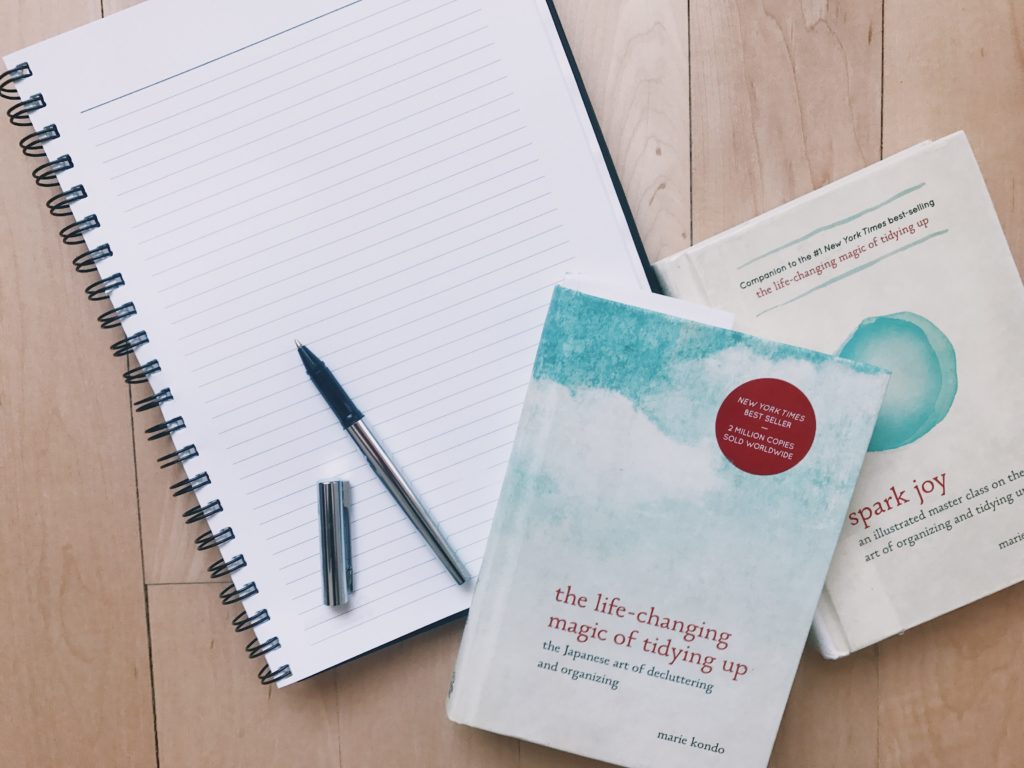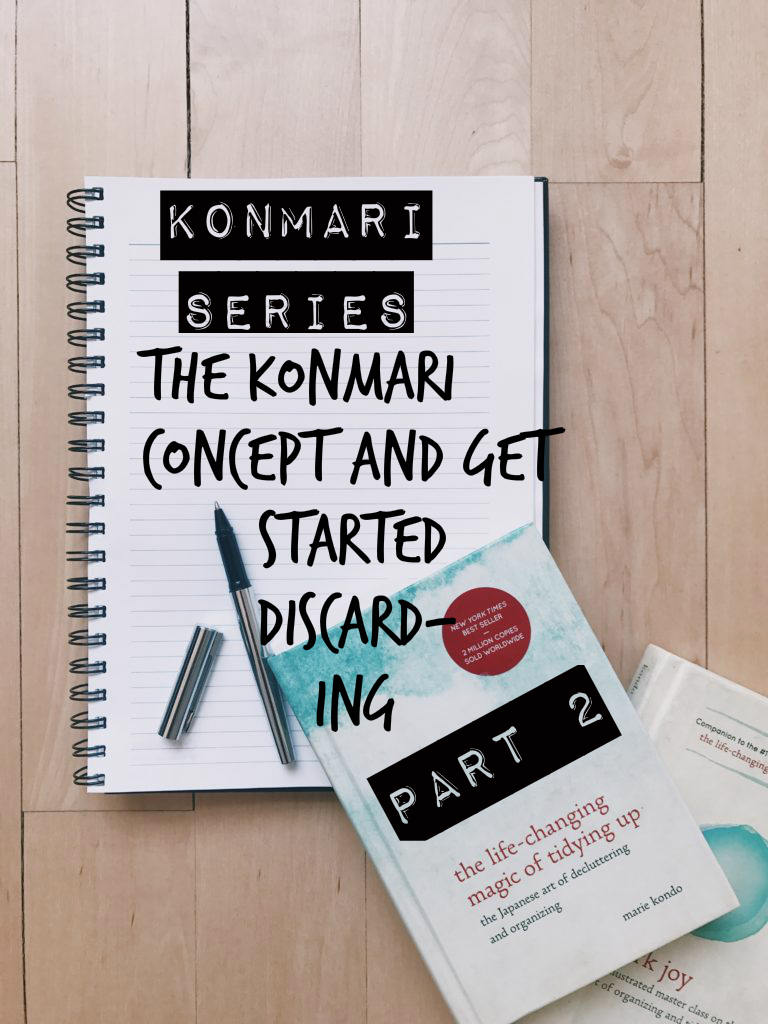This post is part of the KonMari Series in which I document my journey to becoming a certified KonMari consultant. Start from the beginning here and/or see all posts of the series here.
Today, I start with summarizing my notes of Marie Kondo’s first book “The Life-Changing Magic Of Tidying Up.” Since I took a looot of notes, I’m dividing my writing about this book into three posts. In today’s (first) post I cover the KonMari concept in general as well as advice on how to get started with the discarding process.
Please note that this should not serve as a complete summary of the book. However, it should merely be a roundup of points that stood out to me and that I found important. I also add my personal reflections to some aspects.
General Principles
The proclaimed “secret to success” according to Marie Kondo involves the following:
- 1st step: decluttering
- 2nd step: organizing/appointing things you keep (and “spark joy”) a designated home
- Do it completely
- Do it in one go
These are the basic principles of the tidying process which Kondo has trademarked as the KonMari method – a nice play on her name. It is important that you don’t mix up the order of step one and two or do them at the same time as that may ultimately lead to failure. After completing the tidying process, your life is going to change as you’ll see things clearer and find out what’s important in your life.
How To Avoid Rebound
It is important to complete the tidying undertaking in one shot. The reason why this is so important is that you can actually SEE the results if you’re doing it that way and it will cause a complete change of mind. If you’re just doing a little every day you’re not able to see the effects of your decluttering efforts and thus may get discouraged and distracted. But if you’re committing a designated time period to this, you’re more likely to be successful.
Also, if you’re doing it in one blow, you’ll not experience a rebound. Your house will not get cluttered again if you do it this way. In fact, you should aim for perfection! And I couldn’t agree more on this point because why not do it right the first (and last) time and then never have to think about it again. It makes a lot of sense to me and I love that she’s making this bold statement which I’m sure not everyone agrees on.
The Real Incentive To Tidying
Tidying your space allegedly affects your way of thinking, habits and your life in general. According to Kondo, all of her clients report that it has impacted their life in one way or another. In general, it helps people to discover what their true desires are. Clutter only draws attention away from the real issues you face in life and keep you busy. Once you’re relieved from the noise this clutter creates, you have no choice but face what is truly important as well as the fears you have.
And that’s what ultimately matters! Living a life in which you do the things you need and want to do. Having an organized and clutter free home is not the ultimate goal but living the life you want to live and doing the things you want to do is. Thus, it’s important to keep in mind that
tidying is just a tool, not the final destination.
Sort By Category, Not By Location
It’s stressed that you should tackle one category at a time and NOT tidy by location or room. The main reason for this is that you can only see what you have and how much if you gather all the items of one category in one spot. Only then you’re able to find out if there’s duplicates or too many items of something. If you did tidy by location, you wouldn’t be able to assess your inventory of things in that manner at all or as easily.
I will get into the specific categories later as well as the recommended order these should be dealt with. However, the order is influenced by how easy people can make keeping/discarding decisions about them. In this regard, you should start with the “easy” categories first. In doing so, the whole process becomes less difficult.
Before You Start Discarding
It is important to visualize the goal you want to achieve by tidying your belongings. Kondo encourages all her clients to really think about why they want to go through the process and envision their life after. This helps people gain clarity about the reason behind their tidying ambitions and ultimately helps them to push through when they have a weak moment in the middle of it. In the end, everyone just wants to be happy and that’s what the essence of most clients’ end-goal is.
Choose What Sparks Joy For You
An important guideline is that you should choose what you want to keep and not what you want to get rid of. The ultimate goal is that you only keep items that you truly treasure and make your life brighter. In order to be able to find this out, you should take every item in your hand and ask yourself if it “sparks joy.” If it does, you want to keep it. If it doesn’t, you should thank the item for the function it has fulfilled and place it with the items you want to discard.
Oftentimes, people have problems letting go of items with
- functional value
- informational value
- emotional value or
- things that are rare and difficult to replace or re-obtain.
It’s important to be honest to yourself and not hold on to items you feel guilty of letting go. Every item has a function it has fulfilled in your life. You need to find the item’s true purpose and decide it has been fulfilled already and it’s time for the item to go. And that might be very simple. For instance, an item brought you joy in the moment you bought it and now you have no use for it and it no longer brings you joy. Thus, it’s time for the item to go.
Helpful Tips For The Discarding Process
If you live with one or more family members, make sure to not let them see what you’re discarding. They might want to keep any of the items for themselves or question you why you would let go of all these things. I’ve experienced this problem with my husband. It’s always an issue when he sees what I want to discard, especially if it’s expensive things. Thus, I’ll make sure to not let him see what I’ll get rid of when I do my tidying.
Also, it’s important to only do the tidying for your own items. Don’t tidy your partner’s or other family member’s items. First of all, they will (hopefully) get inspired by you, follow your lead and start their own tidying process. It’s important that everyone takes care of their own belongings and decides what to keep and discard. Second, Kondo states that this will help yourself become more comfortable with the “untidyness” of your family members (if this is something that bothers you).
Don’t listen to music or anything like that during the tidying process. You need to be able to have a dialogue with yourself and be undistracted. I totally agree here. I’m not someone who can multi-task (and I truly think no one can) and am only able to concentrate on one thing at a time.
——————–
In the next part of the KonMari series, I will go into the actual decluttering process by category (read it here).



